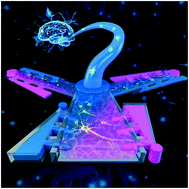Our official English website, www.x-mol.net, welcomes your
feedback! (Note: you will need to create a separate account there.)
Quantifying orientational regeneration of injured neurons by natural product concentration gradients in a 3D microfluidic device†
Lab on a Chip ( IF 6.1 ) Pub Date : 2018-02-21 00:00:00 , DOI: 10.1039/c7lc01143a Yun Tang 1, 2, 3, 4, 5 , Quan-Fa Qiu 1, 2, 3, 4, 5 , Fu-Li Zhang 1, 2, 3, 4, 5 , Min Xie 1, 2, 3, 4, 5 , Wei-Hua Huang 1, 2, 3, 4, 5
Lab on a Chip ( IF 6.1 ) Pub Date : 2018-02-21 00:00:00 , DOI: 10.1039/c7lc01143a Yun Tang 1, 2, 3, 4, 5 , Quan-Fa Qiu 1, 2, 3, 4, 5 , Fu-Li Zhang 1, 2, 3, 4, 5 , Min Xie 1, 2, 3, 4, 5 , Wei-Hua Huang 1, 2, 3, 4, 5
Affiliation

|
Regeneration of injured neurons in complicated three-dimensional (3D) microenvironments is a key approach for treating neurodegenerative diseases. Microfluidics provides a versatile tool to recapitulate cellular microenvironments in vitro, but it still remains a big challenge to construct a microfluidic platform incorporating extracellular matrix (ECM) structures and highly controlled 3D gradients of soluble factors to study the regeneration of injured neurons. In this work, we developed a microfluidic device which can provide multiple adjustable gradients in a 3D ECM to investigate the regeneration of injured central nervous system (CNS) neurons in response to natural small molecules. With interconnecting but independently controlled central channels, asymmetrically designed side channels and a series of microgrooves connecting the central channels, spatially and temporally controlled 3D biochemical gradients can be generated inside collagen hydrogel in the central channels. This allows quantitative analysis of guided axon growth and the orientational regeneration of injured dopaminergic neurons by 3D chemical gradients of three natural molecules. This study demonstrates a promising microfluidic platform for the generation of highly controlled 3D biochemical gradients in an ECM to quantitatively study neuronal responses, thereby potentially facilitating drug screening and optimization of treatment protocols for neurodegenerative diseases.
中文翻译:

在3D微流控设备中通过自然产物浓度梯度来量化受伤神经元的定向再生†
在复杂的三维(3D)微环境中受伤神经元的再生是治疗神经退行性疾病的关键方法。微流体技术提供了一种通用的工具,可在体外概括细胞微环境但是,构建一个包含细胞外基质(ECM)结构和高度受控的可溶性因子3D梯度的微流体平台来研究受损神经元的再生仍然是一个巨大的挑战。在这项工作中,我们开发了一种微流体装置,该装置可以在3D ECM中提供多个可调节的梯度,以研究对自然小分子的反应中受伤的中枢神经系统(CNS)神经元的再生。通过相互连接但独立控制的中央通道,不对称设计的侧通道和连接中央通道的一系列微沟槽,可以在中央通道中的胶原水凝胶内部生成时空受控的3D生化梯度。这允许通过三个天然分子的3D化学梯度对引导的轴突生长和受伤的多巴胺能神经元的定向再生进行定量分析。这项研究展示了一个有前途的微流体平台,用于在ECM中生成高度受控的3D生化梯度,以定量研究神经元反应,从而潜在地促进药物筛选和神经退行性疾病治疗方案的优化。
更新日期:2018-02-21
中文翻译:

在3D微流控设备中通过自然产物浓度梯度来量化受伤神经元的定向再生†
在复杂的三维(3D)微环境中受伤神经元的再生是治疗神经退行性疾病的关键方法。微流体技术提供了一种通用的工具,可在体外概括细胞微环境但是,构建一个包含细胞外基质(ECM)结构和高度受控的可溶性因子3D梯度的微流体平台来研究受损神经元的再生仍然是一个巨大的挑战。在这项工作中,我们开发了一种微流体装置,该装置可以在3D ECM中提供多个可调节的梯度,以研究对自然小分子的反应中受伤的中枢神经系统(CNS)神经元的再生。通过相互连接但独立控制的中央通道,不对称设计的侧通道和连接中央通道的一系列微沟槽,可以在中央通道中的胶原水凝胶内部生成时空受控的3D生化梯度。这允许通过三个天然分子的3D化学梯度对引导的轴突生长和受伤的多巴胺能神经元的定向再生进行定量分析。这项研究展示了一个有前途的微流体平台,用于在ECM中生成高度受控的3D生化梯度,以定量研究神经元反应,从而潜在地促进药物筛选和神经退行性疾病治疗方案的优化。











































 京公网安备 11010802027423号
京公网安备 11010802027423号